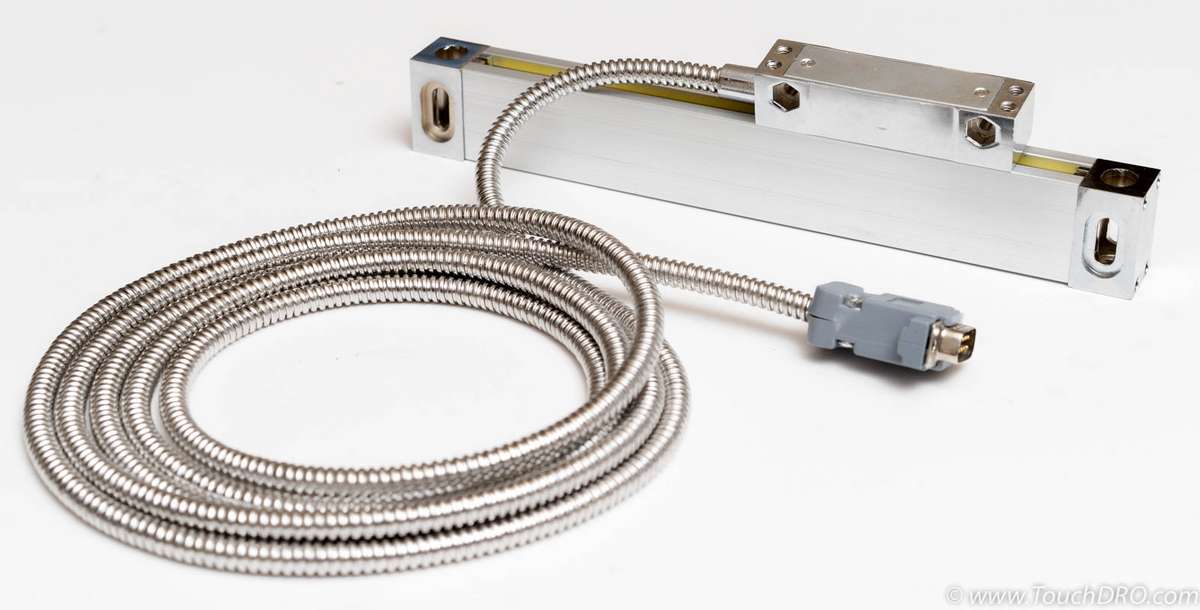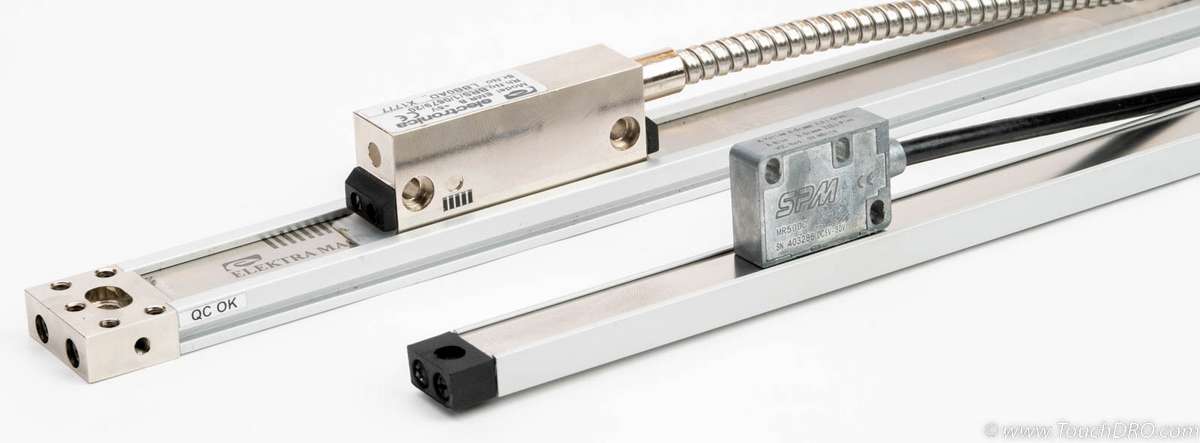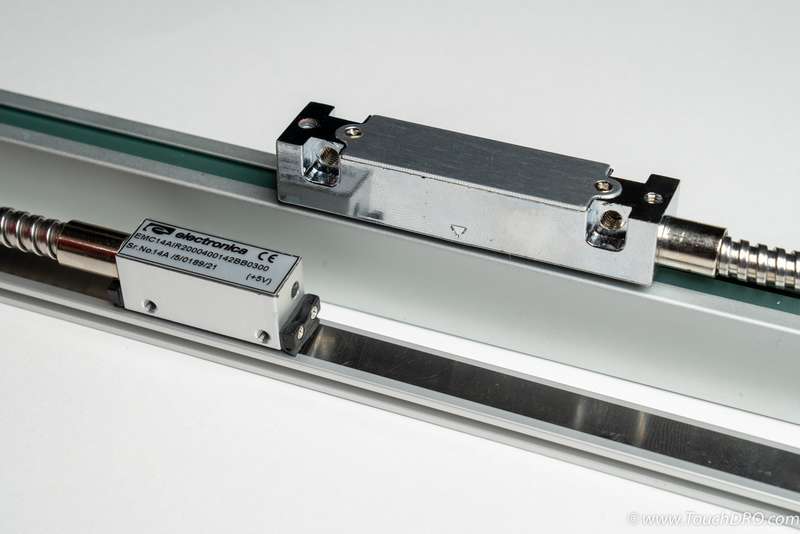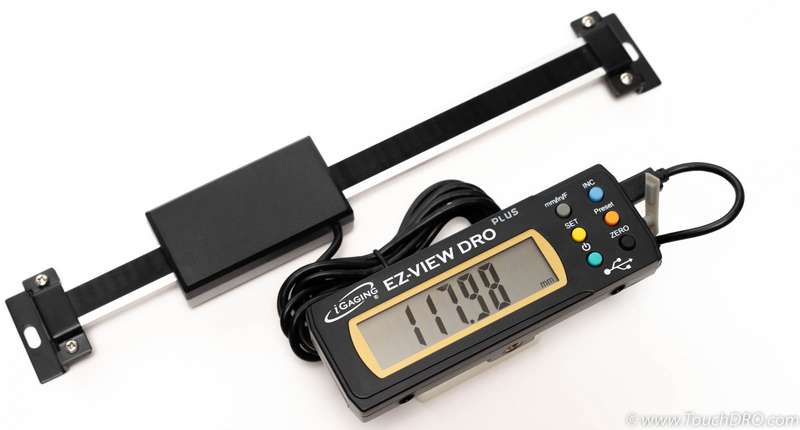DRO Scale Selection Guide
Your selection of scales will have the biggest impact on performance, reliability and accuracy of your DRO. There are many different types of DRO scales, but these days, most people use glass, magnetic, or capacitive scales. Glass and magnetic scales have very similar characteristics and are very close in performance and reliability; both have some unique benefits and drawbacks. Capacitive scales can be used in a budget DRO setup, but they are not as good as the other two types and are not a good choice in the long run. With all this said, let's look at each scale type in more detail.
Glass Scales

Glass DRO scales use a combination of glass encoder strip with precisely etched marks and an array of optointerrupters to measure the travel distance. The glass has relatively low coefficient of thermal expansion, so the laser-etched encoder strips can be very precise and accurate. Glass scales are by far the most prevalent, since they offer a very good balance of accuracy, reliability, and price. They are very well protected from dirt and moisture ingestion, and when mounted correctly, can last for decades without any major issues. In case a scale is contaminated, it's usually relatively easy to take it apart and carefully clean with isopropyl alcohol.
Most common glass scales have 5-micron resolution, but there are 1-micron models as well. High-end digital readouts often use proprietary scales that include additional features, such as zero reference marks or areas, error correction track, etc. Most Chinese DROs, on the other hand, use standard 5V TTL or RS422 glass scales that are largely interchangeable (although connectors often need to be reconfigured to match the pinout of the display unit).
Their main drawbacks are that they are bulkier than other scales, can't be easily cut to size, and have to be mounted with the opening facing away to avoid ingestion of chips and coolant. Basically, they are harder to mount, especially when the space is limited. On the plus side, imported glass scales are very inexpensive, and even the lowest-cost ones are generally very decent.
Buying Tips
Chinese glass DRO scales range in price from as little as $70 for non-name scales from eBay or AliExpress to over $200 per scale from US or European suppliers. The accuracy is virtually identical across the price range, since the encoder parts are made only by a handful of manufacturers who have their process well dialed in. In other words, even the cheapest scales will be as accurate as their more expensive counterparts, but you will likely encounter the following:
- Amplification electronics are of lower grade. Very often the circuit is hand-built by low-wage unskilled workers to save cost.
- Less weather sealing. Good scales come with two pairs or seals; cheap scales usually have only one pair to save a few cents.
- The overall workmanship and quality control are not as good as the more expensive scales. It's common to find stripped threads, missing hardware and cosmetic blemishes.
- Cheaper shipping materials. Very often cheaper scales don't come with the bracket that restrains the head from moving during shipping (the head might be taped or "saran wrapped"
- Documentation might be missing or incorrect and post-sales support is often non-existent
Overall, even the cheap scales usually work fine. Most of the common issues are not critical, and if you are comfortable with some soldering, you will be able to fix things like loose solder joints, etc. Better scales don't have these problems, and if you buy them from a decent vendor, you will usually have reasonable warranty and support.
Magnetic Scales

Magnetic scales use magnetic tape to measure the distance. The reader is analogue in nature. It measures the magnitude of a relatively coarse magnetic field using two sets of hall effect sensors and then uses sine/cosine interpolation to provide fine distance readout. Just like glass scales, magnetic scales come in 5-micron and 1-micron versions, but some manufacturers offer models with 10 and even 20 micron resolution. 5-micron scales use 5mm pole-to-pole tape, and 1-micron scales use 2mm pole-to-pole tape. The tape is often interchangeable and can be custom ordered with specialized reference marks, etc. Majority of modern magnetic scales use 5V TTL/RS422 quadrature output, but there are models that output 1V sine/cosine wave.
Magnetic scales have a few advantages over glass scales. First of all, they are not affected by condensation and moisture. Second, magnetic DRO scales have very good vibration and shock resistance characteristics. Finally, magnetic scales are less bulky than glass scales and can be easily cut to size. For various reasons, magnetic scales are less common in DRO applications than glass scales.

The main disadvantage of magnetic scales is their higher price. The circuit that converts analog sine/cosine waves to quadrature output (sine/cosine interpolation) is much more complex than the reader used in the glass scales. Moreover, the tape must be temperature stable, have precisely spaced magnetic poles, and a very consistent distribution of magnetic particles. In other words, it is much harder and more expensive to make good magnetic tape than to etch a piece of glass. As a result, magnetic scales cost several times more than glass scales of comparable quality.
Until recently, only a few high-end manufacturers produced these scales, and the price was out of the reach of most small shops. During the past decade, inexpensive Chinese magnetic scales came to market, and Electronica/EMS started offering a few reasonably affordable mid-range models.
Chinese magnetic scales in particular, have very attractive prices, but it's important to understand what the tradeoffs are (compared to EMS scales, for example). The area where Chinese manufacturers cut costs are more important with magnetic scales. First of all, there are several versions of interpolation circuits used to convert analog magnetic reading to precise position. Fast and accurate implementations are also more expensive, so the manufacturers often sacrifice speed, accuracy, or both to hit a particular price point. Second, consistent and temperature stable magnetic tape is expensive and requires proprietary high-tech polymers. The tape you get with Chinese scales can be no better than refrigerator tape (technologies are very similar), which negatively affects the accuracy.
Special Note
Electronica/EMS scales come with two-track tape. The main track has a standard 5 mm or 2 mm pole-to-pole grid, and the secondary track has periodic reference marks (more info: http://www.electronicaems.com/Magnetic-Tape.php). The company offers tape with a custom reference track that has a single mark at a predefined position. This can be used with TouchDRO glass scale adapter to provide a homing position. The Z pin for the scale would be connected to the relevant "home" input. The position of the home mark should be at the end of the scale, since TouchDRO will zero out the scale on both sides of the pulse.
Buying Tips
At the time of this writing, magnetic scales are still much less common and the number of choices is much smaller than glass scales. Electronica/EMS (in the USA sold by DRO Pros) are the best somewhat affordable scales. The other option is Chinese scales (often Ditron-branded). These are about half of the price, but there are some shortcomings that you need to understand:
- Chinese scales use less sophisticated interpolation circuits. It is a bit slower (which might be irrelevant for a manual DRO) and has less robust error correction. As a result, swarf can have a bigger effect on the accuracy.
- Good magnetic encoder tape is very expensive; so, this is where Chinese manufacturers cut costs. Chinese tape is less consistent, less temperature-stable, and more sensitive to WD-40 and other chemicals.
- Most Chinese scales come with bulk tape, as opposed to high quality scales that come with tape mounted into aluminum extrusion and protected from the elements.
In short, Electronica/EMS magnetic scales are very accurate and offer excellent quality and performance. Chinese magnetic scales are much less expensive, but you will sacrifice some accuracy and consistency; other than the lower grade tape, and cheaper electronics, these scales are pretty durable.
Capacitive Scales

Capacitive scales use capacitance to measure travel distance. This technology has been used in digital calipers for decades and can be very accurate. Unfortunately, these scales are not intended for use in machine DROs. With the exception of a few very expensive Mitutoyo DROs, capacitive scales are not used by mainstream digital readout manufacturers.
Due to their low cost, Chinese capacitive scales became a popular choice for DIY digital readouts in the early 2000's; so, in 2010's iGaging introduced a model with a remote display (they called it iGaging DigiMag Remote DRO). Since their display is separate from the scale, it can be mounted in a convenient location. More importantly, the protocol is very simple and can be easily read by a simple DIY circuit.
Chinese capacitive scales are relatively inexpensive and can be easily cut to size to fit into tight places. Majority of scales have resolution around 10 micron (iGaging EZ-View uses an oddball resolution of 9.6 micron) and provide either 1.5V or 3V output.
These scales have many drawbacks compared to glass and magnetic scales:

- The resolution is limited to 10 micron
- Chinese scales have very poor noise protection, and the frame is connected to the ground or Vcc by design. Consequently, the scales are very sensitive to ground loops and electromagnetic noise, and the readout can be very unreliable and unstable.
- Inexpensive scales use aluminum extrusion for the frame and plastic reading head, which are very dimensionally unstable
- Scale frames are completely exposed and the reading heads have no weather sealing, so the scales are easily contaminated/damaged by swarf and cutting fluids.
- Refresh rate is fixed and relatively slow, so you might notice some lag of the DRO screen
Buying Tips
Frankly, if you are shopping for DRO scales, capacitive scales make little sense. They have many serious drawbacks. In the past, tenfold difference in price between glass and capacitive scales made up for these drawbacks. These days, the prices are very close, especially for longer models; capacitive scales with stainless steel frames often cost more than cheap glass scales. Given the small price difference, the tradeoffs are not worth it.
If you already have a set of capacitive scales, TouchDRO will expand their usefulness. Latest versions of TouchDRO adapters do a good job of mitigating most noise and stability issues. However, the result will not be as robust as one that uses dedicated DRO scales.
Conclusion
In summary, for a new DRO setup, glass or magnetic scales are the best choice. Glass scales offer the best price-to-performance ratio. In some cases, they might be too bulky for specific applications. For example, mounting a glass scale to a quill on a milling machine might be impractical. Similarly, a large glass scale on a small lathe's cross slide might take too much space. In those cases, you might want to use a magnetic scale. In either case, 5-micron scales are a solid choice for most machines; on a lathe, consider using a 1-micron scale on the cross slide, which will give an effective resolution of 2 microns (since for each micron you are taking two microns in diameter).
Note that with TouchDRO (and many modern mid-range DROs), it's possible to mix and match scale types. The difference is that with a traditional DRO, you will likely need to re-solder the connectors to match the display's pinout and, most likely, will have to use the same resolution. In TouchDRO, you can mix scales with different resolutions and even different types of scales.
